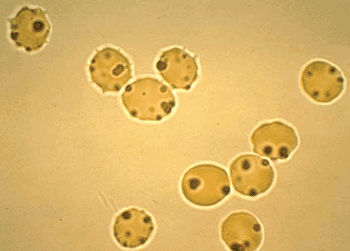Enzymatic Assay Validated for G6PD Deficiency
By LabMedica International staff writers
Posted on 02 Jul 2013
The distribution of the most common human enzyme defect, glucose-6-phosphate dehydrogenase (G6PD) deficiency, is linked to areas of high malaria endemicity.Posted on 02 Jul 2013
The majority of methods for assessing G6PD deficiency have shortcomings for field use and there is a lack of a standard diagnostic test to identify those identified with the enzymopathy as the cause of severe hemolysis following administration of certain antimalarial drugs.

Image: Heinz bodies in erythrocytes indicative of G6PD-deficiency (Photo courtesy of Institute of Tropical Medicine).
Tropical medical specialists at the London School of Hygiene and Tropical Medicine (UK) working with colleagues in Uganda, enrolled 235 children under the age of five years from randomly selected households into a cohort study. Blood spots were collected by finger-prick onto filter paper at routine visits, and G6PD activity was determined by two different tests.
A commercial standard reagent of known G6PD activity (Trinity Biotech; Bray, Co Wicklow, Ireland) was used to create a panel of normal, moderate, and severe deficiency (100%, 30%, and 10% activity respectively), as well as a no-enzyme control (0%). Blood spots and controls were tested by both the optimized formazan substrate (WST8/1) phenazine methosulfate (WST8/1-methoxy PMS) assay, and by the commercially available standard R&D systems test (Minneapolis, MN, USA). Results were evaluated both visually and quantitatively.
The WST8/1-methoxy PMS assay was found to have 72% sensitivity and 98% specificity when compared to the commercial enzymatic assay and the area under the curve (AUC) was 0.904, suggesting good agreement. Misclassifications were at borderline values of G6PD activity between mild and normal levels, or related to outlier hemoglobin (Hb) values of less than 8.0 gHb/dL or greater than 14 gHb/dL) which were associated with ongoing anemia or recent hemolytic crises.
The authors concluded that the assay was found to be highly robust for field use, showing less light sensitivity, good performance over a wide temperature range, and good capacity for medium-to-long term storage. The WST8/1-methoxy PMS assay was comparable to the currently used standard enzymatic test, and offers advantages in terms of cost, storage, portability and use in resource-limited settings. The study was published on June 19, 2013, in the Malaria Journal.
Related Links:
London School of Hygiene and Tropical Medicine
Trinity Biotech
R&D systems







 Analyzer.jpg)






